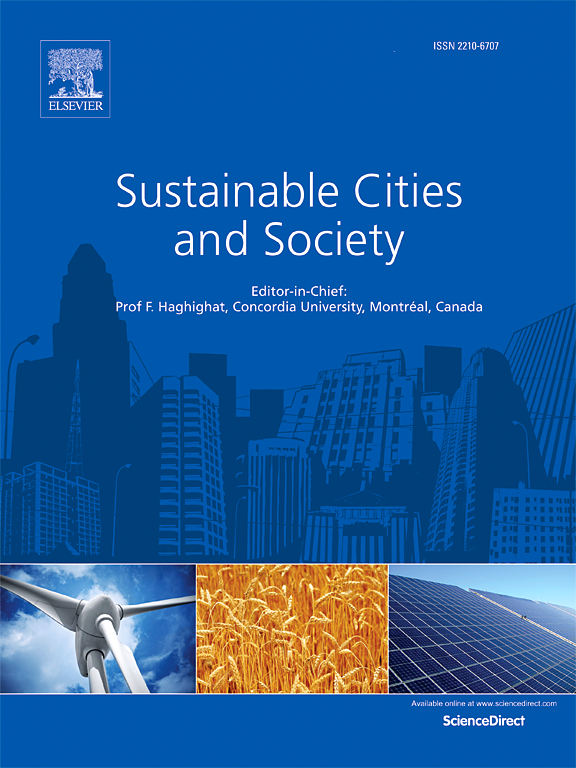基于社会媒体数据和贝叶斯网络的城市洪水风险评价:武汉市时空动态分析
IF 10.5
1区 工程技术
Q1 CONSTRUCTION & BUILDING TECHNOLOGY
引用次数: 0
摘要
在城市化和气候变化的双重影响下,城市洪涝灾害已成为城市发展的主要威胁之一,而城市洪涝灾害风险的时空演变尚不清楚。本研究利用社交媒体数据对2012-2023年武汉市洪水淹没区域进行了划分,并采用基于贝叶斯网络的方法对城市洪水风险进行了评估。此外,考虑各种气候和土地利用情景,对未来风险进行了评估。结果表明,洪涝灾害主要集中在城市中部。道路密度和不透水路面是影响洪水的主要因素。2100年,在SSP5-8.5和SSP2-4.5情景下,高风险地区占比将比历史同期平均增加3.13%(由14.66%增加到17.79%)。土地利用变化对南部地区的影响更大。而北方地区降水变化的影响更为显著,土地利用变化的影响比降水变化更为显著。研究表明,贝叶斯网络模型可以有效地描述城市洪水的复杂过程和概率特征。该方法将结合未来气候和土地利用情景,为气候变化下的洪水风险精细化管理提供科学依据,从而增强城市抵御能力。本文章由计算机程序翻译,如有差异,请以英文原文为准。
Urban flood risk evaluation using social media data and Bayesian network approach: A spatial-temporal dynamic analysis in Wuhan city, China
Under the dual impacts of urbanization and climate change, urban flooding has become one of the major threats to urban development, while the spatial-temporal evolution of urban flood risk remains unclear. In this study, we delineated the inundation areas of flooding in Wuhan from 2012–2023 using social media data and assessed urban flood risk through a Bayesian network based approach. Furthermore, future risks were evaluated considering various climate and land use scenarios. The results show that flood events are mainly concentrated in the central part of the city. Road density and impervious surfaces are identified as the primary factors influencing flooding. The proportion of high-risk areas will increase by an average of 3.13 % (from 14.66 % to 17.79 %) in 2100 under the SSP5–8.5 and SSP2–4.5 scenarios compared to the historical period. Land use alterations have a greater influence in the southern region. In contrast, variations in precipitation have a more substantial impact in the northern region and the influence of land use change is more significant compared to precipitation change. This study indicates that the Bayesian network model can effectively depict the complex process and probabilistic characteristics of urban floods. Integrated with future climate and land use scenarios, this approach would provide a scientific basis for the refined management of flood risk under climate change, thereby enhancing urban resilience.
求助全文
通过发布文献求助,成功后即可免费获取论文全文。
去求助
来源期刊

Sustainable Cities and Society
Social Sciences-Geography, Planning and Development
CiteScore
22.00
自引率
13.70%
发文量
810
审稿时长
27 days
期刊介绍:
Sustainable Cities and Society (SCS) is an international journal that focuses on fundamental and applied research to promote environmentally sustainable and socially resilient cities. The journal welcomes cross-cutting, multi-disciplinary research in various areas, including:
1. Smart cities and resilient environments;
2. Alternative/clean energy sources, energy distribution, distributed energy generation, and energy demand reduction/management;
3. Monitoring and improving air quality in built environment and cities (e.g., healthy built environment and air quality management);
4. Energy efficient, low/zero carbon, and green buildings/communities;
5. Climate change mitigation and adaptation in urban environments;
6. Green infrastructure and BMPs;
7. Environmental Footprint accounting and management;
8. Urban agriculture and forestry;
9. ICT, smart grid and intelligent infrastructure;
10. Urban design/planning, regulations, legislation, certification, economics, and policy;
11. Social aspects, impacts and resiliency of cities;
12. Behavior monitoring, analysis and change within urban communities;
13. Health monitoring and improvement;
14. Nexus issues related to sustainable cities and societies;
15. Smart city governance;
16. Decision Support Systems for trade-off and uncertainty analysis for improved management of cities and society;
17. Big data, machine learning, and artificial intelligence applications and case studies;
18. Critical infrastructure protection, including security, privacy, forensics, and reliability issues of cyber-physical systems.
19. Water footprint reduction and urban water distribution, harvesting, treatment, reuse and management;
20. Waste reduction and recycling;
21. Wastewater collection, treatment and recycling;
22. Smart, clean and healthy transportation systems and infrastructure;
 求助内容:
求助内容: 应助结果提醒方式:
应助结果提醒方式:


